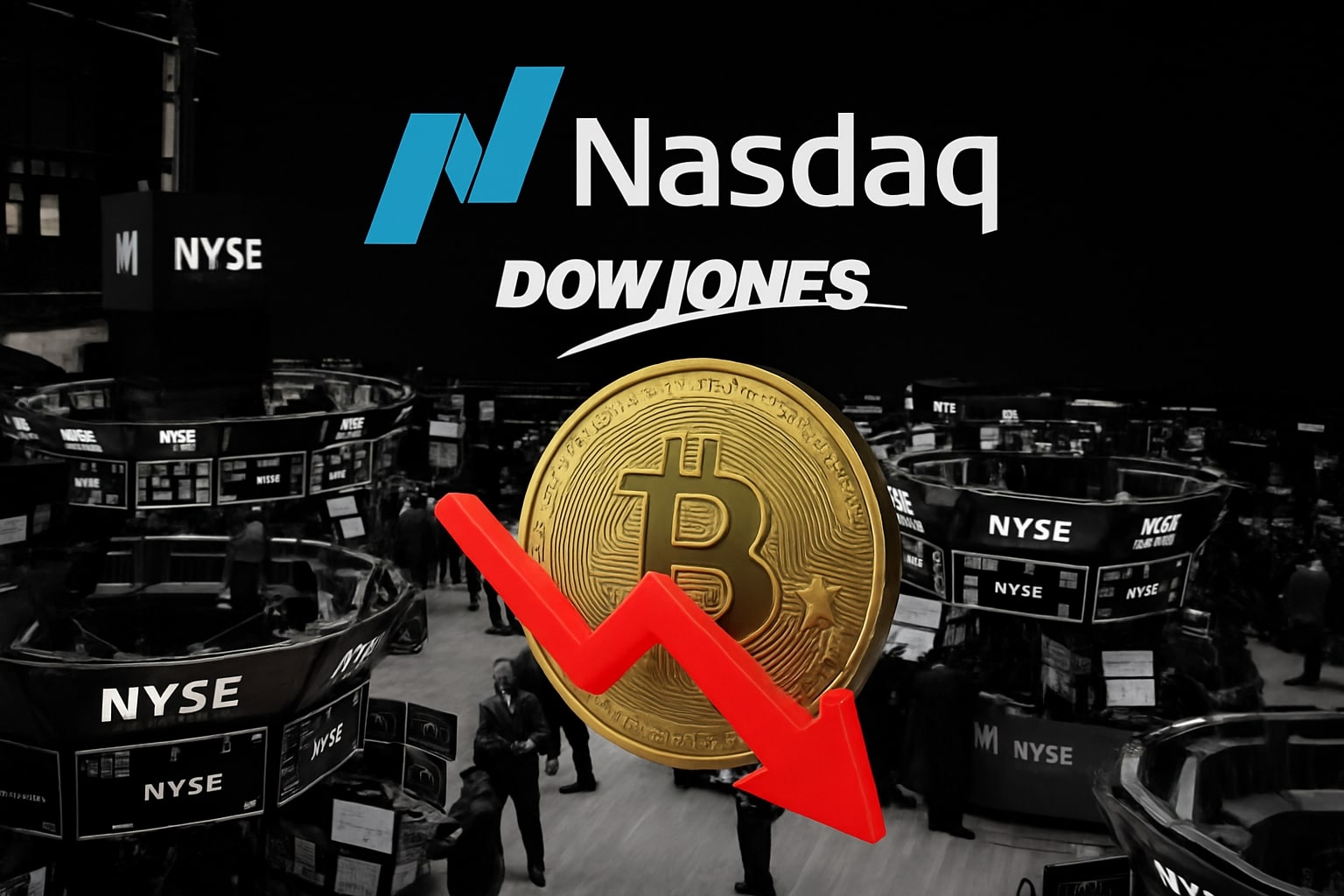
Stock Market Today: NASDAQ Recovers, DOW Slides 300, S&P 500 Holds 6,736 as Bitcoin (BTC-USD) Drops Below $95,000
Tech unwinds again as NVDA, TSLA, ORCL swing sharply; gold falls to $4,077, VIX jumps above 21, and fading Fed cut odds trigger the deepest cross-asset selloff in weeks | That's TradingNEWS
Stock Market Today - Market Turbulence Intensifies Across NASDAQ, S&P 500, DOW As Rate-Cut Confidence Cracks And Tech Unwinds
The unraveling in NASDAQ, S&P 500, and DOW accelerated into Friday with a sequence of forced liquidations, collapsing risk appetite, and a violent reset in expectations for a December FED cut. Futures on all three major benchmarks reflected a market losing its anchor: DOW futures down 0.6%, S&P 500 futures down nearly 1%, and NASDAQ 100 futures down 1.5%. The depth of the selling broke through multiple support levels, with the VIX punching above 21 for the first time since the October volatility spike.
Weakness originated inside the highest-valuation segments — cloud, semiconductors, and AI-linked megacaps — but quickly spread across the entire market structure. The three-day sequence carved the steepest combined losses for NASDAQ since early July and marked the worst session in more than a month for S&P 500 and DOW, erasing virtually all weekly gains in a 48-hour window. The RUSSELL 2000 amplified the pain, dropping more than 1.5% Friday after a 2.8% plunge Thursday, confirming a broad-based de-risking rather than narrow tech-only pressure.
Hawkish Fed Messaging Resets December Expectations And Forces A Repricing Across US500 DJI IXIC
The collapse in rate-cut confidence is now the central gravitational force dragging equities, crypto, precious metals, and leveraged trades sharply lower. Probability of a December cut fell from 95% one month ago to below 50% today, marking one of the fastest tightening in forward expectations since early 2022.
Boston Fed President Susan Collins warned she would be “hesitant” to ease without inflation data that remains unavailable due to the 43-day government shutdown, while Minneapolis’ Neel Kashkari emphasized mixed economic signals — resilient consumer spending yet stubborn inflation and uneven sectoral performance.
This hawkish shift forced a repricing across the curves: the U.S. 10-year yield near 4.12%, the 2-month bill slipping toward 3.85%, and volatility climbing as rate-sensitive trades unwound.
The shutdown’s data blackout is increasingly problematic — October inflation and employment readings may never be published, leaving the FOMC potentially forced to make a December decision without critical data. This absence of clarity is now a market risk itself.
Tech Rotation Hits NVDA TSLA ORCL MSFT META AMD As AI Valuation Stress Erupts
The most crowded trade of 2025 — AI megacap dominance — finally met resistance. Selling hit the same names that carried indices to record highs:
TSLA fell more than 4% premarket, slipping under the $400 line and suffering its worst day since July.
NVDA extended Thursday’s slump with another 3% premarket decline, although dip buyers later pulled it back more than 0.5% intraday.
ORCL, the catalyst for this week’s tech panic, fell another 2–3% after multi-day losses triggered by concerns about its cloud reliance on OpenAI and elevated AI capex commitments.
MSFT, META, AAPL, and AMD all opened lower before stabilizing mid-session, reflecting algorithmic selling rather than a breakdown in fundamental sentiment.
Market strategists flagged the same issue: tech multiples were pricing perfection. The combination of rising yields, hawkish Fed language, and record-high leveraged positioning was enough to ignite a reversal. The S&P 500 Technology Sector Index had fallen 2.4% Thursday, then flipped positive intraday Friday as bargain hunters selectively returned — but the sector remains negative week-to-date.
Crypto Enters A Sharp Deleveraging Cycle As BTC And Major Tokens Sink Under Margin Stress
The crypto complex mirrored the violent moves in equities. BTCUSD collapsed below $96,000, hitting an intraday low of $94,519, its weakest price since May. This solidifies the decline at more than 20% from its early-October peak above $126,000, entering a technical bear-market threshold.
ETF outflows accelerated for a fourth straight day, cascading into forced liquidations across derivatives markets. Long-duration holders, who remained steady during earlier drawdowns, began distributing into weakness — a bearish shift that hasn’t appeared since Q4 2022.
Crypto-linked equities slumped as well:
COIN fell sharply before stabilizing,
MSTR slid nearly 2%,
HOOD dropped before rebounding 2%+ in mid-trade.
Margin reductions across AI-tech, gold, and crypto confirm a cross-asset deleveraging cycle rather than isolated weakness.
Gold And Silver Break Hard As Margin Calls Trigger A Broad Commodity Flush
Gold futures collapsed nearly 3% to $4,077, marking one of the worst sessions of the year. Silver dropped more than 4%, retreating from record highs set Wednesday.
This is not a fundamental shift — it is purely liquidity-driven. As traders closed positions across tech, crypto, and FX, metals were liquidated to free margin.
Traders flagged one critical note: gold’s multi-month rally was heavily margin-supported. When the unwind hit, everything correlated to zero.
Oil diverged — WTI jumped more than 2.5% to around $60.25 after the Ukrainian drone strike on a Russian Black Sea port. Natural gas cooled off Thursday’s highs.
Corporate Crosscurrents: WMT DIS AMAT WBD CSCO STUB Highlight Diverging Fundamentals
Corporate news added fuel to the volatility:
WMT fell 2–3% after CEO Doug McMillon announced his retirement, triggering concerns about strategic continuity.
AMAT beat on revenue at $6.8B vs. $6.67B expected and delivered strong AI-linked Q1 guidance — yet the stock sank 3–5% as the broader tech derisking overwhelmed good news.
WBD jumped nearly 3% as PARA, NFLX, and CMCSA prepared bids ahead of the Nov. 20 initial deadline.
WHR surged 3% after Appaloosa disclosed a major stake.
CSCO issued one of the few upbeat tech outlooks: fiscal 2026 revenue raised to $60.2B–$61B and guided $3B AI infrastructure revenue, sending CSCO higher and partially offsetting tech gloom.
STUB collapsed 23% after refusing to offer quarterly guidance and reporting a $1.33B net loss tied to stock-based compensation.
Investors shifted back toward companies with clean balance sheets, visible free cash flow, and AI infrastructure exposure — while punishing speculative, debt-loaded, or guidance-light firms.
China Weakness Adds Global Pressure As BABA JD BIDU XPENG Sink On Slowing Retail And Industrial Output
China’s October retail sales rose 2.9%, the slowest YTD. Industrial production also printed its weakest growth since January. The data pushed US-listed Chinese equities lower:
BABA, JD, BIDU, XPEV all saw renewed pressure as investors pulled capital into safer U.S. assets.
The global slowdown narrative — China softness, U.K. bond carnage, U.S. volatility — intensified recession concerns for 2026.
Tariff Shifts, Political Headlines, And Cross-Border Deals Reshape Macro Sentiment
Macro headlines carried heavy weight this session:
The U.S.–Switzerland tariff reduction deal (from 39% to 15%) strengthened the Swiss franc and pressured U.S. import-linked stocks.
President Trump’s plan to reduce tariffs on coffee and Latin American agricultural imports pushed coffee futures lower for a third day.
Trump also confirmed plans to attend Davos 2026 in person — a symbolic shift that markets view as a precursor to renewed global trade agendas.
Technical Breakdown Levels For NASDAQ S&P 500 DOW Become Key Into Weekly Close
Both NASDAQ and S&P 500 are now threatening their 50-day moving averages, a threshold algos watch aggressively.
Breaks below these levels would unlock further systematic selling:
S&P 500 at 6,736–6,740 zone,
NASDAQ at approximately 22,900–23,000,
DOW retreating from its 48,000 all-time high to nearly 47,150.
The DOW just booked its steepest two-day decline since April — immediately after reaching a record high. That reversal pattern historically correlates with multi-week consolidation.
Read More
-
Alibaba Stock Price Forecast - BABA Shares Drops Toward $153 As Market Pullback Hits China Tech
14.11.2025 · TradingNEWS ArchiveStocks
-
XRP Price Forecast - XRP-USD Drops To $2.32 As XRP ETF Euphoria Collides With Market Liquidations
14.11.2025 · TradingNEWS ArchiveCrypto
-
Natural Gas (NG=F) Stalls Below $5.00 After A 40% Winter Rally
14.11.2025 · TradingNEWS ArchiveCommodities
-
JBND ETF Stabilizes Near $54.16 as Cooling Real Yields and Firm Credit Spreads Fuel a Stronger Outlook
13.11.2025 · TradingNEWS ArchiveMarkets
-
USD/JPY Price Forecast - Yen Climbs Toward 155.00 As Policy Divergence and Missing U.S. CPI
14.11.2025 · TradingNEWS ArchiveForex
Weekly Outlook: Risk-Off Momentum Persists Unless Data Returns And Fed Tone Softens
With macro data delayed, policy uncertainty elevated, and leverage stressed across multiple asset classes, the market heads into next week vulnerable.
The decisive factor will be the release of the long-delayed September and October labor/inflation data. If the data remains unavailable, volatility remains elevated.
Tech will need confirmation of durable AI demand and stability in yields before buyers return with conviction.
Crypto must find a stable liquidation bottom.
Gold must rebuild after a margin-wipeout.
And indices must protect their 50-day averages or risk deeper algorithmic selling.
Final Verdict Across The Market: NASDAQ Bearish S&P 500 Cautious DOW Hold Bitcoin Bearish Gold Neutral To Bullish On Pullback
NASDAQ (IXIC): Bearish
Momentum cracked, valuations stretched, and leverage unwinding. Needs stabilization above 22,800.
S&P 500 (US500): Hold/Cautious
More diversified, but still hostage to rate-cut odds. A break under 6,700 opens downside risk.
Dow Jones (DJI): Hold
Less exposed to AI leverage. Pullback looks corrective, not structural.
Bitcoin (BTCUSD): Bearish
A 20% drop from highs + ETF outflows + long-holder distribution = further risk ahead unless reclaimed above $100,000.
Gold (GC00): Neutral → Bullish
Today’s crash was margin-related. Fundamentally still supported by real yields, currency instability, and rate-cut cycles.



















